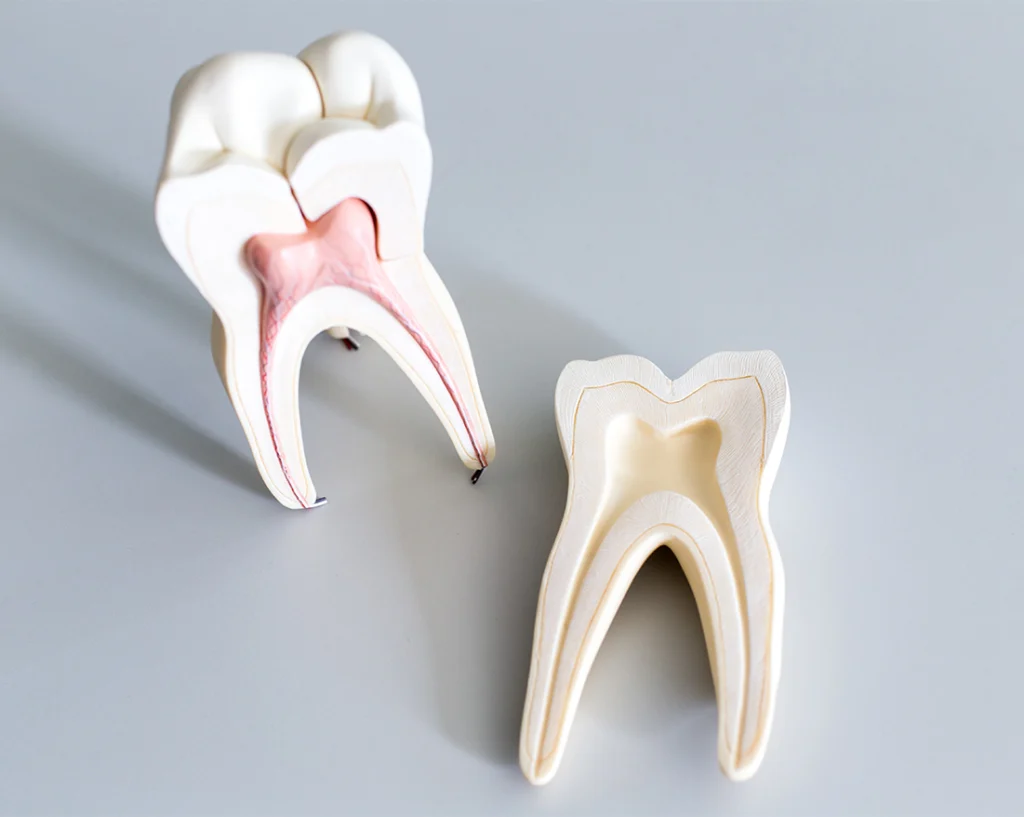Introduction to Dental Implants
Dental implants are a revolutionary advancement in modern dentistry, recognized as the gold standard for replacing missing teeth. They provide a permanent and durable solution, restoring both the function and aesthetics of a natural smile. Unlike traditional tooth replacement options such as dentures and bridges, dental implants offer unparalleled stability and longevity, significantly enhancing oral health and quality of life.
The primary role of dental implants is to mimic the natural structure of a tooth, ensuring that patients can chew, speak, and smile with confidence. They are designed to integrate seamlessly with the jawbone, providing a sturdy foundation for artificial teeth that look and feel just like real ones. This integration not only restores functionality but also preserves the surrounding bone and facial structure, preventing the sunken appearance often associated with tooth loss.
When compared to other tooth replacement options, dental implants stand out due to their durability, natural appearance, and positive impact on overall oral health. While dentures and bridges may offer temporary solutions, implants provide a long-term fix that maintains the integrity of the dental arch and avoids the need for altering adjacent healthy teeth.
Anatomy of a Dental Implant
A dental implant consists of several key components, each playing a crucial role in the overall success and functionality of the replacement tooth:
Implant Post (Fixture)
The implant post, typically made of titanium or zirconia, serves as the artificial root of the tooth. Surgically placed into the jawbone, it acts as a stable foundation that integrates with the bone through a process called osseointegration. Titanium is renowned for its biocompatibility and ability to fuse with bone, while zirconia offers a metal-free alternative with similar integration properties.
Abutment
The abutment is the connector piece that links the implant post to the crown. It protrudes above the gum line and provides a secure base for attaching the prosthetic tooth. Abutments can be customized in shape and size to accommodate the specific needs of each patient, ensuring a precise fit and optimal functionality.
Crown (Prosthesis)
The crown is the visible part of the dental implant, designed to resemble a natural tooth in both appearance and function. Typically made from ceramic or porcelain, crowns are customized to match the color, shape, and size of the surrounding teeth, providing a seamless and aesthetically pleasing result.
The materials used in dental implants, particularly titanium and zirconia, are chosen for their biocompatibility and ability to integrate with the bone, ensuring that the implant remains stable and durable over time. This osseointegration process is critical, as it allows the implant to function as a reliable and long-lasting replacement for natural teeth.
Candidates for Dental Implants
Not everyone is an ideal candidate for dental implants. Successful implantation depends on several factors related to overall health and oral condition:
Adequate Bone Density
Sufficient jawbone density is essential to support the implant post. Bone loss, often resulting from periodontal disease or prolonged tooth loss, can compromise the stability of implants. Patients with inadequate bone density may require bone grafting or other preparatory procedures to augment the jawbone before implant placement.
Healthy Gums
Healthy gum tissue is crucial for the success of dental implants. Gum disease must be treated and controlled before implant placement to ensure that the surrounding tissues can support the implant and prevent future infections.
General Health
Overall health plays a significant role in implant success. Chronic conditions such as diabetes or autoimmune diseases can affect healing and increase the risk of implant failure. Additionally, habits like smoking can impair osseointegration and increase the likelihood of complications.
For patients who do not initially qualify for dental implants due to bone loss or other factors, preparatory procedures such as bone grafting or sinus lifts can be performed to enhance bone density and create a suitable environment for implant placement.
The Benefits of Dental Implants
Dental implants offer numerous advantages over traditional tooth replacement methods, encompassing functional, aesthetic, and long-term oral health benefits:
Restoring Full Function
Implants allow patients to chew, speak, and smile naturally, without the fear of slippage or discomfort often associated with removable dentures. This restoration of full functionality enhances the overall quality of life and confidence.
Preventing Bone Loss
Unlike bridges or dentures, dental implants stimulate the jawbone, preventing bone resorption that typically occurs after tooth loss. This preservation of bone density maintains facial structure and prevents the sunken appearance associated with prolonged tooth absence.
Durability and Longevity
Dental implants boast a high success rate, with 90–95% of implants remaining stable and functional over a span of 10 years or more. With proper care, implants can last a lifetime, making them a cost-effective and long-term solution compared to other options that may require frequent replacements.
Preserving Facial Structure
By maintaining bone density and preventing bone loss, dental implants help preserve the natural contours of the face. This prevents the sagging and sunken facial features that can result from missing teeth and bone deterioration.
Improved Oral Health
Dental implants do not require the reduction of adjacent healthy teeth, as bridges do. This preservation of natural tooth structure allows for better oral hygiene and reduces the risk of decay and gum disease in neighboring teeth.
Aesthetics
Implants provide a natural-looking appearance, seamlessly blending with existing teeth. The customizable nature of crowns ensures that implants match the color, shape, and size of surrounding teeth, offering a discreet and aesthetically pleasing solution.
The Dental Implant Procedure
The dental implant process involves multiple stages, each crucial for ensuring the success and longevity of the implant. Here is a step-by-step overview of the procedure:
Initial Consultation and Treatment Planning
The journey begins with a comprehensive oral examination, which includes X-rays and 3D imaging (CBCT scans) to evaluate bone density and plan the precise placement of the implant. This phase ensures that the implant is strategically positioned for optimal function and aesthetics.
Implant Placement Surgery
Under local anesthesia or sedation, the implant post is surgically placed into the jawbone. Precise positioning is essential to ensure proper integration and alignment with the surrounding teeth. The implant site is then allowed to heal, typically taking 3–6 months, during which osseointegration occurs as the bone fuses with the implant.
Abutment Placement and Crown Fitting
Once osseointegration is complete, the abutment is attached to the implant post. A custom-made crown is then fabricated to match the patient’s natural teeth and is securely placed onto the abutment. In some cases, immediate implants or same-day implants may be possible, allowing the crown to be placed on the same day as the implant surgery.
Advanced Procedures for Implant Success
In certain cases, additional surgical procedures may be necessary to ensure the success of dental implants:
Bone Grafting
Bone grafting involves adding bone material to areas of the jawbone that have insufficient density or volume. This augmentation provides a stable foundation for the implant, enhancing osseointegration and long-term stability.
Sinus Lift
For implants placed in the upper molar area, a sinus lift may be required to add bone height in the maxillary sinus region. This procedure ensures that there is adequate bone to support the implant, preventing complications and enhancing the success rate.
Guided Tissue Regeneration
Guided tissue regeneration techniques promote bone and tissue growth around the implant site. This ensures that the implant is well-integrated with the surrounding structures, providing a robust and stable foundation for the crown.
While these advanced procedures add time to the overall treatment plan, they significantly increase the chances of long-term success and stability for dental implants.
Pain Management and Recovery After a Dental Implant
Concerns about pain and discomfort during and after dental implant procedures are common, but modern advancements have made implant surgery relatively pain-free and manageable:
Pain During the Procedure
Dental implant surgery is performed under local anesthesia, ensuring that the patient does not feel pain during the procedure. Sedation options are also available for patients who experience anxiety, further enhancing comfort during the surgery.
Recovery Process
Post-operative recovery is generally smooth. Patients may experience mild discomfort or swelling in the days following the surgery, which can be managed with over-the-counter pain medications such as ibuprofen. Applying cold compresses to the outside of the mouth can help reduce swelling and numb pain.
Managing Discomfort
- Over-the-Counter Pain Medications: Ibuprofen or acetaminophen can help alleviate mild discomfort.
- Cold Compresses: Applying ice packs to the cheeks can reduce swelling and numb pain.
- Soft Foods: Consuming soft foods helps protect the surgical site and reduces irritation.
Follow-up Appointments
Follow-up visits are essential to monitor healing and ensure the implant is integrating correctly. During these appointments, the dentist will check the surgical site, assess osseointegration, and plan the placement of the abutment and crown if not done immediately.
Restoration and the Role of Dental Crowns
After a root canal or implant placement, restoring the tooth with a dental crown is crucial for functionality and longevity:
Importance of Dental Crowns
Dental crowns provide structural support and protection to the treated tooth or implant. They restore the tooth’s shape, size, and strength, allowing it to function like a natural tooth and preventing fractures or other damage.
Process of Crown Placement
- Preparation: The dentist prepares the treated tooth by reducing its size and shaping it to accommodate the crown.
- Impressions or Digital Scans: Precise molds or digital scans of the tooth are taken to create a custom-made crown that matches the patient’s natural teeth.
- Fitting the Crown: Once the crown is ready, it is cemented onto the prepared tooth, restoring its appearance, strength, and functionality.
Properly placed crowns ensure that the dental implant or treated tooth remains protected and functional, contributing to the long-term success of the restoration.
When a Root Canal is Not Enough
While root canal therapy is highly effective, there are instances where it may not suffice to save the tooth:
Inadequate Cleaning of the Canals
If the canals are not thoroughly cleaned and disinfected, bacteria can remain, leading to reinfection and the need for retreatment. Proper technique and thoroughness during the procedure are essential to prevent this complication.
Complicated Anatomy
Teeth with complex root structures, such as curved or narrow canals, can harbor bacteria even after treatment. Specialized tools and techniques are required to address these complexities effectively, but in some cases, complete removal of the pulp may not be achievable.
Delayed Treatment
Delays in addressing pulp damage or infection can result in widespread infection and significant deterioration of the tooth structure. In such cases, root canal therapy alone may be insufficient, necessitating additional surgical options.
When root canal therapy fails, retreatment or surgical procedures like apicoectomy (removal of the root tip) may be necessary to resolve the issue and preserve the tooth.
Alternatives to Root Canal Therapy
While root canal therapy is the preferred method for saving a damaged or infected tooth, there are alternative treatment options available, primarily tooth extraction:
Tooth Extraction
Extraction involves removing the affected tooth entirely. While this can resolve immediate pain and infection, it has several drawbacks:
- Loss of Natural Tooth: Removing the tooth disrupts the dental arch and can lead to shifting of surrounding teeth.
- Need for Replacement: Replacing an extracted tooth often requires implants, bridges, or dentures, which can be more costly and complex compared to saving the tooth with a root canal.
Comparison of Root Canal Therapy and Extraction
| Aspect | Root Canal Therapy | Tooth Extraction |
|---|---|---|
| Preservation of Natural Tooth | Yes | No |
| Functionality | Restores full functionality | May require prosthetics |
| Aesthetics | Maintains natural appearance | May affect smile and facial structure |
| Cost | Generally lower than implants or bridges | Requires additional treatments for replacement |
| Procedure Complexity | Requires specialized treatment | Simple extraction, but replacement is complex |
In most cases, root canal therapy is the preferred option as it preserves the natural tooth, maintains the integrity of the dental arch, and avoids the need for additional procedures required by tooth extraction.
The Cost of Dental Implants
The cost of dental implants can vary widely based on several factors, including the number of implants needed, the complexity of the procedure, and the materials used. Typically, the cost encompasses the implant post, abutment, crown, and any additional procedures such as bone grafting or sinus lifts.
Breakdown of Costs
- Implant Post: $1,000 – $3,000 per implant
- Abutment: $500 – $1,000 per abutment
- Crown: $800 – $3,000 per crown
- Additional Procedures: Bone grafting ($300 – $3,000), Sinus lift ($1,500 – $3,000)
Long-term Cost-effectiveness
While dental implants may have a higher upfront cost compared to dentures or bridges, their durability and longevity make them a cost-effective solution in the long run. Implants typically last a lifetime with proper care, reducing the need for frequent replacements and additional dental work.
Financing Options and Insurance Coverage
Many dental practices offer financing options to help patients manage the cost of implants. Additionally, some dental insurance plans may cover a portion of the expenses, especially if the implants are deemed medically necessary. Patients are encouraged to discuss financial options and insurance coverage with their dental provider to make informed decisions.
Success Rates and Potential Risks
Dental implants boast a high success rate, typically ranging from 90–95%, depending on factors such as patient health, implant placement accuracy, and oral hygiene practices. However, like any medical procedure, there are potential risks and complications to be aware of:
High Success Rates
Studies have shown that dental implants are highly successful, with most implants remaining stable and functional for many years. Success rates are higher in patients with good oral and overall health, adequate bone density, and those who adhere to proper oral hygiene practices.
Potential Complications
- Peri-implantitis: Inflammation and infection around the implant site, which can lead to bone loss and implant failure if not treated promptly.
- Implant Failure: Occurs when the implant does not properly integrate with the bone, often due to poor bone density, smoking, or uncontrolled diabetes.
- Nerve Damage or Sinus Issues: Improper placement of the implant can result in nerve injury, causing numbness or tingling, or sinus complications in the upper jaw.
These risks are minimized by working with experienced and skilled implant specialists, adhering to proper surgical protocols, and maintaining excellent oral hygiene post-treatment.
Mitigating Risks
To reduce the likelihood of complications, patients should:
- Choose a qualified and experienced implant specialist.
- Follow pre- and post-operative care instructions diligently.
- Maintain excellent oral hygiene to prevent peri-implantitis.
- Avoid smoking and manage chronic health conditions effectively.
Maintenance and Caring for Dental Implants
Proper maintenance is essential to ensure the longevity and functionality of dental implants. With the right care, implants can last a lifetime, providing a natural and stable solution for missing teeth.
Good Oral Hygiene
Maintaining a daily oral hygiene routine is crucial for the health of dental implants. This includes:
- Brushing: Brush at least twice a day with fluoride toothpaste, using a soft-bristled toothbrush to avoid damaging the gums and implant.
- Flossing: Floss daily using interdental brushes or floss threaders to remove plaque and food particles around the implant and abutment.
- Using Mouthwash: An antimicrobial mouthwash can help reduce bacteria and maintain overall oral hygiene.
Regular Dental Visits
Regular check-ups and professional cleanings are essential to monitor the health of the implant and surrounding tissues. During these visits, the dentist can detect and address any issues early, ensuring the implant remains stable and healthy.
Lifestyle Considerations
- Avoid Smoking: Smoking can impair healing and increase the risk of implant failure.
- Wear a Nightguard: If you grind or clench your teeth (bruxism), wearing a nightguard can protect the implant and prevent damage to the crown.
- Healthy Diet: A balanced diet rich in vitamins and minerals supports overall oral health and the integrity of the implant.
Managing Potential Complications
While rare, complications such as peri-implantitis require prompt attention. Patients should be vigilant for signs of inflammation, such as redness, swelling, or bleeding around the implant site, and seek dental care immediately if these symptoms arise.
Early detection and treatment of complications ensure the long-term success of dental implants and prevent more severe issues from developing.
Implant Alternatives
While dental implants are the preferred method for replacing missing teeth, there are alternative options available, each with its own set of benefits and drawbacks:
Dentures (Partial or Full)
Dentures are removable appliances that replace missing teeth and surrounding tissues. They are less expensive upfront compared to implants but may feel less secure and require more maintenance. Dentures can also cause bone resorption over time, affecting facial structure and requiring adjustments or replacements.
Bridges
A dental bridge involves creating a false tooth (pontic) anchored to adjacent healthy teeth using crowns. While bridges provide a fixed solution, they require altering healthy teeth for support, which can compromise their integrity. Bridges may also need to be replaced more frequently than implants and do not prevent bone loss in the jaw.
Comparison of Dental Implants and Alternatives
| Aspect | Dental Implants | Dentures | Bridges |
|---|---|---|---|
| Durability | Highly durable, can last a lifetime with proper care | Less durable, may need replacements every 5-10 years | Moderately durable, typically last 10-15 years |
| Aesthetics | Natural-looking, indistinguishable from real teeth | Less natural, can sometimes slip or feel bulky | Natural-looking but requires healthy adjacent teeth |
| Oral Health Impact | Preserves bone density and does not affect adjacent teeth | Can cause bone resorption and requires adhesives | Requires altering adjacent healthy teeth, does not prevent bone loss |
| Maintenance | Requires regular oral hygiene and dental visits | Requires daily removal, cleaning, and securement | Requires good oral hygiene and care of adjacent teeth |
| Cost | Higher upfront cost but cost-effective long-term | Lower upfront cost but may incur higher costs over time | Moderate cost with potential for future replacements |
While dental implants are generally the preferred option for their numerous benefits, patient-specific factors such as bone density, budget, and personal preferences may make dentures or bridges more suitable for some individuals.
The Cost of Dental Implants
The cost of dental implants can vary significantly based on several factors, including the number of implants needed, the complexity of the procedure, and the materials used. Typically, the cost encompasses the implant post, abutment, crown, and any additional procedures such as bone grafting or sinus lifts.
Breakdown of Costs
- Implant Post: $1,000 – $3,000 per implant
- Abutment: $500 – $1,000 per abutment
- Crown: $800 – $3,000 per crown
- Additional Procedures: Bone grafting ($300 – $3,000), Sinus lift ($1,500 – $3,000)
Long-term Cost-effectiveness
While dental implants may have a higher upfront cost compared to dentures or bridges, their durability and longevity make them a cost-effective solution in the long run. Implants typically last a lifetime with proper care, reducing the need for frequent replacements and additional dental work.
Financing Options and Insurance Coverage
Many dental practices offer financing options to help patients manage the cost of implants. Additionally, some dental insurance plans may cover a portion of the expenses, especially if the implants are deemed medically necessary. Patients are encouraged to discuss financial options and insurance coverage with their dental provider to make informed decisions.
Success Rates and Potential Risks
Dental implants boast a high success rate, typically ranging from 90–95%, depending on factors such as patient health, implant placement accuracy, and oral hygiene practices. However, like any medical procedure, there are potential risks and complications to be aware of:
High Success Rates
Studies have shown that dental implants are highly successful, with most implants remaining stable and functional for many years. Success rates are higher in patients with good oral and overall health, adequate bone density, and those who adhere to proper oral hygiene practices.
Potential Complications
- Peri-implantitis: Inflammation and infection around the implant site, which can lead to bone loss and implant failure if not treated promptly.
- Implant Failure: Occurs when the implant does not properly integrate with the bone, often due to poor bone density, smoking, or uncontrolled diabetes.
- Nerve Damage or Sinus Issues: Improper placement of the implant can result in nerve injury, causing numbness or tingling, or sinus complications in the upper jaw.
These risks are minimized by working with experienced and skilled implant specialists, adhering to proper surgical protocols, and maintaining excellent oral hygiene post-treatment.
Mitigating Risks
To reduce the likelihood of complications, patients should:
- Choose a qualified and experienced implant specialist.
- Follow pre- and post-operative care instructions diligently.
- Maintain excellent oral hygiene to prevent peri-implantitis.
- Avoid smoking and manage chronic health conditions effectively.
Maintaining and Caring for Dental Implants
Proper maintenance is essential to ensure the longevity and functionality of dental implants. With the right care, implants can last a lifetime, providing a natural and stable solution for missing teeth.
Good Oral Hygiene
Maintaining a daily oral hygiene routine is crucial for the health of dental implants. This includes:
- Brushing: Brush at least twice a day with fluoride toothpaste, using a soft-bristled toothbrush to avoid damaging the gums and implant.
- Flossing: Floss daily using interdental brushes or floss threaders to remove plaque and food particles around the implant and abutment.
- Using Mouthwash: An antimicrobial mouthwash can help reduce bacteria and maintain overall oral hygiene.
Regular Dental Visits
Regular check-ups and professional cleanings are essential to monitor the health of the implant and surrounding tissues. During these visits, the dentist can detect and address any issues early, ensuring the implant remains stable and healthy.
Lifestyle Considerations
- Avoid Smoking: Smoking can impair healing and increase the risk of implant failure.
- Wear a Nightguard: If you grind or clench your teeth (bruxism), wearing a nightguard can protect the implant and prevent damage to the crown.
- Healthy Diet: A balanced diet rich in vitamins and minerals supports overall oral health and the integrity of the implant.
Managing Potential Complications
While rare, complications such as peri-implantitis require prompt attention. Patients should be vigilant for signs of inflammation, such as redness, swelling, or bleeding around the implant site, and seek dental care immediately if these symptoms arise.
Early detection and treatment of complications ensure the long-term success of dental implants and prevent more severe issues from developing.
Implant Alternatives
While dental implants are the preferred method for replacing missing teeth, there are alternative options available, each with its own set of benefits and drawbacks:
Dentures (Partial or Full)
Dentures are removable appliances that replace missing teeth and surrounding tissues. They are less expensive upfront compared to implants but may feel less secure and require more maintenance. Dentures can also cause bone resorption over time, affecting facial structure and requiring adjustments or replacements.
Bridges
A dental bridge involves creating a false tooth (pontic) anchored to adjacent healthy teeth using crowns. While bridges provide a fixed solution, they require altering healthy teeth for support, which can compromise their integrity. Bridges may also need to be replaced more frequently than implants and do not prevent bone loss in the jaw.
Comparison of Dental Implants and Alternatives
| Aspect | Dental Implants | Dentures | Bridges |
|---|---|---|---|
| Durability | Highly durable, can last a lifetime with proper care | Less durable, may need replacements every 5-10 years | Moderately durable, typically last 10-15 years |
| Aesthetics | Natural-looking, indistinguishable from real teeth | Less natural, can sometimes slip or feel bulky | Natural-looking but requires healthy adjacent teeth |
| Oral Health Impact | Preserves bone density and does not affect adjacent teeth | Can cause bone resorption and requires adhesives | Requires altering adjacent healthy teeth, does not prevent bone loss |
| Maintenance | Requires regular oral hygiene and dental visits | Requires daily removal, cleaning, and securement | Requires good oral hygiene and care of adjacent teeth |
| Cost | Higher upfront cost but cost-effective long-term | Lower upfront cost but may incur higher costs over time | Moderate cost with potential for future replacements |
| Procedure Complexity | Requires specialized treatment | Simple to fit, but requires regular adjustments | Requires preparation of adjacent teeth |
While dental implants are generally the preferred option for their numerous benefits, patient-specific factors such as bone density, budget, and personal preferences may make dentures or bridges more suitable for some individuals.
The Cost of Dental Implants
The cost of dental implants can vary significantly based on several factors, including the number of implants needed, the complexity of the procedure, and the materials used. Typically, the cost encompasses the implant post, abutment, crown, and any additional procedures such as bone grafting or sinus lifts.
Breakdown of Costs
- Implant Post: $1,000 – $3,000 per implant
- Abutment: $500 – $1,000 per abutment
- Crown: $800 – $3,000 per crown
- Additional Procedures: Bone grafting ($300 – $3,000), Sinus lift ($1,500 – $3,000)
Long-term Cost-effectiveness
While dental implants may have a higher upfront cost compared to dentures or bridges, their durability and longevity make them a cost-effective solution in the long run. Implants typically last a lifetime with proper care, reducing the need for frequent replacements and additional dental work.
Financing Options and Insurance Coverage
Many dental practices offer financing options to help patients manage the cost of implants. Additionally, some dental insurance plans may cover a portion of the expenses, especially if the implants are deemed medically necessary. Patients are encouraged to discuss financial options and insurance coverage with their dental provider to make informed decisions.
Success Rates and Potential Risks
Dental implants boast a high success rate, typically ranging from 90–95%, depending on factors such as patient health, implant placement accuracy, and oral hygiene practices. However, like any medical procedure, there are potential risks and complications to be aware of:
High Success Rates
Studies have shown that dental implants are highly successful, with most implants remaining stable and functional for many years. Success rates are higher in patients with good oral and overall health, adequate bone density, and those who adhere to proper oral hygiene practices.
Potential Complications
- Peri-implantitis: Inflammation and infection around the implant site, which can lead to bone loss and implant failure if not treated promptly.
- Implant Failure: Occurs when the implant does not properly integrate with the bone, often due to poor bone density, smoking, or uncontrolled diabetes.
- Nerve Damage or Sinus Issues: Improper placement of the implant can result in nerve injury, causing numbness or tingling, or sinus complications in the upper jaw.
These risks are minimized by working with experienced and skilled implant specialists, adhering to proper surgical protocols, and maintaining excellent oral hygiene post-treatment.
Mitigating Risks
To reduce the likelihood of complications, patients should:
- Choose a qualified and experienced implant specialist.
- Follow pre- and post-operative care instructions diligently.
- Maintain excellent oral hygiene to prevent peri-implantitis.
- Avoid smoking and manage chronic health conditions effectively.
Conclusion
Dental implants represent a safe, effective, and highly desirable solution for replacing missing teeth. They offer unparalleled benefits in terms of functionality, aesthetics, and long-term oral health, making them the gold standard in tooth replacement. By preserving natural tooth structure, preventing bone loss, and providing a stable and natural-looking restoration, dental implants significantly enhance the quality of life for those experiencing tooth loss.
Early evaluation and consultation with a qualified implant specialist are essential to determine candidacy and develop a personalized treatment plan. With proper care and maintenance, dental implants can last a lifetime, offering a reliable and aesthetically pleasing solution that rivals natural teeth. Investing in dental implants not only restores a confident smile but also contributes to overall oral health and well-being, underscoring their importance in modern dental care.
Patients are encouraged to seek prompt treatment if they experience tooth loss, ensuring that they benefit from the advanced capabilities of dental implants and maintain optimal ora









